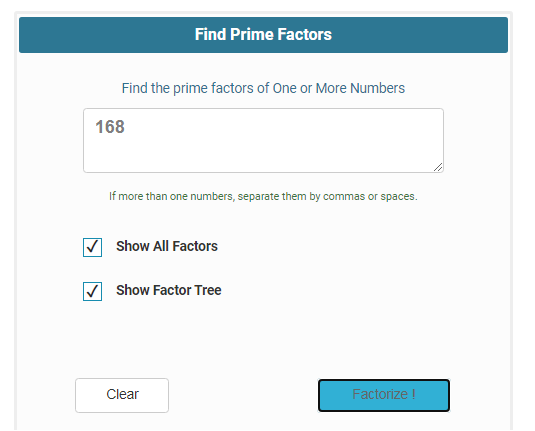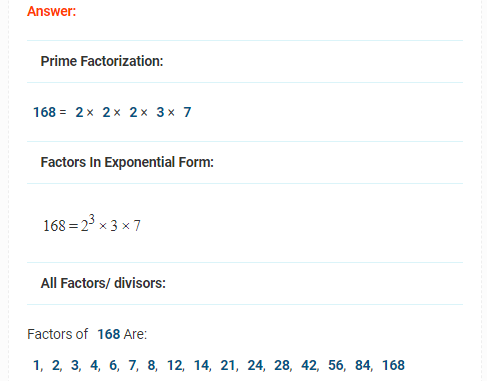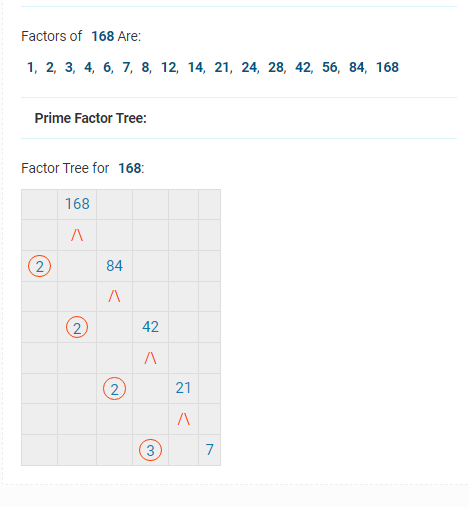Prime factorization calculator
Find Prime Factors
What is prime factorization?
What is prime factorization or what are prime factors? Prime factorization is a way of expressing a number as a product of prime factors. Any integer n can be expressed as a product of prime factors as follows n =p_0 ... p_n, where p_i > 1 and prime. While dealing with prime factorization, it is essential to have an understanding of prime numbers. A prime number is defined as an integer
All the above are ways in which we can factorize
Theorem: For any number
How the prime factoring calculator with exponents works
Step 1 Enter a number on the text space provided and hit factorize ! button

Our Prime factorization calculator works by finding a list of all prime factors for a given number. The calculator then displays the results in various formats such as factor tree, exponent format etc. In addition, the calculator has an option to display all the factors of a given number. This allows user to compare and understand the real meaning of prime factorization. Unlike other online prime factorization calculator, ours gives you an opportunity to learn and understand prime factorization from different perspectives. In particular, the calculator shows you the relation between the divisors and prime factors of a number.
Factor Calc solution Step 1

With appropriate display of factors and divisors, users can easily pick out other important elements between numbers such as GCF/ GCD and LCM.
The calculator works well with both large and small numbers. It can be used for any number less than 1,000,000,000.
Prime Factor Calc solution Step 2

How to find the prime factors of a number
There are two basic methods that we use to find the prime factors of any number namely trial and error division and factor tree method.
Factorization by trial division
This method is quite easy to follow and is useful in finding the prime factors for smaller numbers. First we start off by dividing the number with the first well known prime factor
Example:
Find the prime factors of 168
168 \divide 2=84 save
84 \divide 2=42 save
42 \divide 2=21 save
21 \divide 3=7 save
168 = 2 \times 2 \times 2 \times 3 \times 7
168=2^3 \times 3 \times 7
More Examples by the prime factor calc
Prime factorization by factor tree
A factor tree allows one to visualize the factorization process by displaying the relation between a number and its factors. From the factor tree, it is easy to pick out the prime factors for a particular number.
Example 3: Factor 240 using a factor tree
Application of prime factorization
Our prime factorization finder is fun and easy to use. In addition it gives you ton of useful information that you can apply in other areas of mathematics. Prime factors are quite useful in mathematics and can be applied in various calculations.
Finding GCD/ GCF and LCM using prime factorization
When factoring polynomials it is essential to find the prime factors of its coefficient in order to get its prime factorization. Prime factors are also used in finding the GCD and LCM of numbers. For example when finding the GCD of a given numbers, we find prime factors of each then pick the factor with the lowest power that is common between the numbers. The GCD is then found by finding the product of these factors.
Example: Find the GCD of 168 and 72
Factorize (168) = 2 \times 2 \times 2 \times 3 \times 7=2^3 \times 3^1 \times 7^1
Factorize (96) = 2 \times 2 \times 2 \times 2 \times 2 \times 3 = 2^5 \times 3^1
Thus, GCD(168,96) =2^3 \times 3=24
To Learn more about GCD, visit GCF Calculator
On the other hand, when finding the LCM, we take the highest power of the common factors and find the product.
E.g. LCM(168,96) = 2^5 \times 3^1 \times 7^1 = 672
To Learn more about LCM, visit LCM Calculator